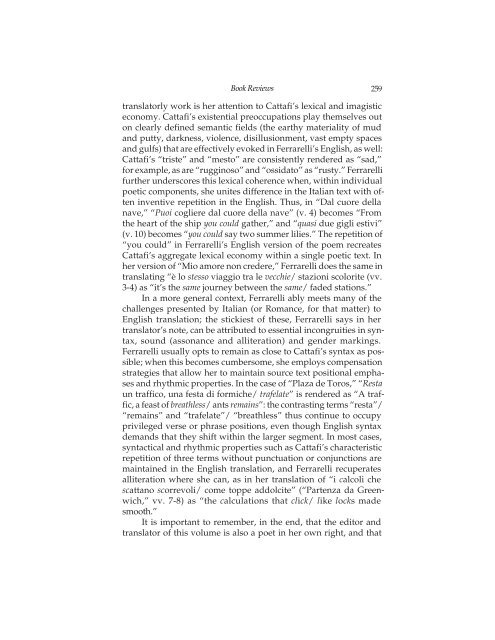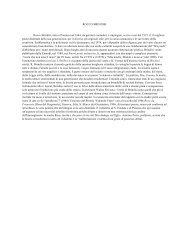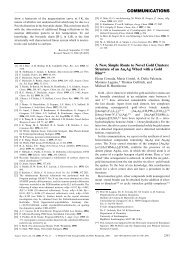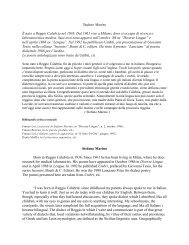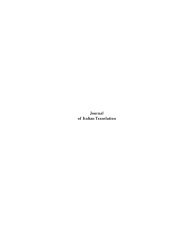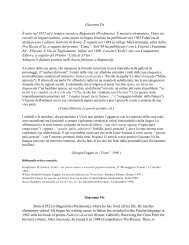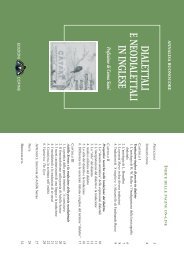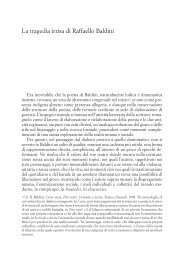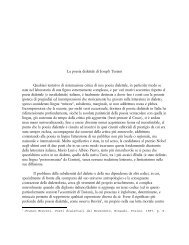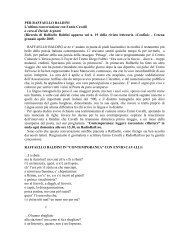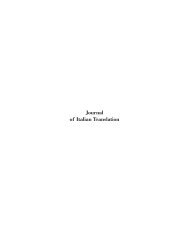Journal of Italian Translation - Brooklyn College - Academic Home ...
Journal of Italian Translation - Brooklyn College - Academic Home ...
Journal of Italian Translation - Brooklyn College - Academic Home ...
You also want an ePaper? Increase the reach of your titles
YUMPU automatically turns print PDFs into web optimized ePapers that Google loves.
Book Reviews<br />
259<br />
translatorly work is her attention to Cattafi’s lexical and imagistic<br />
economy. Cattafi’s existential preoccupations play themselves out<br />
on clearly defined semantic fields (the earthy materiality <strong>of</strong> mud<br />
and putty, darkness, violence, disillusionment, vast empty spaces<br />
and gulfs) that are effectively evoked in Ferrarelli’s English, as well:<br />
Cattafi’s “triste” and “mesto” are consistently rendered as “sad,”<br />
for example, as are “rugginoso” and “ossidato” as “rusty.” Ferrarelli<br />
further underscores this lexical coherence when, within individual<br />
poetic components, she unites difference in the <strong>Italian</strong> text with <strong>of</strong>ten<br />
inventive repetition in the English. Thus, in “Dal cuore della<br />
nave,” “Puoi cogliere dal cuore della nave” (v. 4) becomes “From<br />
the heart <strong>of</strong> the ship you could gather,” and “quasi due gigli estivi”<br />
(v. 10) becomes “you could say two summer lilies.” The repetition <strong>of</strong><br />
“you could” in Ferrarelli’s English version <strong>of</strong> the poem recreates<br />
Cattafi’s aggregate lexical economy within a single poetic text. In<br />
her version <strong>of</strong> “Mio amore non credere,” Ferrarelli does the same in<br />
translating “è lo stesso viaggio tra le vecchie/ stazioni scolorite (vv.<br />
3-4) as “it’s the same journey between the same/ faded stations.”<br />
In a more general context, Ferrarelli ably meets many <strong>of</strong> the<br />
challenges presented by <strong>Italian</strong> (or Romance, for that matter) to<br />
English translation; the stickiest <strong>of</strong> these, Ferrarelli says in her<br />
translator’s note, can be attributed to essential incongruities in syntax,<br />
sound (assonance and alliteration) and gender markings.<br />
Ferrarelli usually opts to remain as close to Cattafi’s syntax as possible;<br />
when this becomes cumbersome, she employs compensation<br />
strategies that allow her to maintain source text positional emphases<br />
and rhythmic properties. In the case <strong>of</strong> “Plaza de Toros,” “Resta<br />
un traffico, una festa di formiche/ trafelate” is rendered as “A traffic,<br />
a feast <strong>of</strong> breathless/ ants remains”: the contrasting terms “resta”/<br />
“remains” and “trafelate”/ “breathless” thus continue to occupy<br />
privileged verse or phrase positions, even though English syntax<br />
demands that they shift within the larger segment. In most cases,<br />
syntactical and rhythmic properties such as Cattafi’s characteristic<br />
repetition <strong>of</strong> three terms without punctuation or conjunctions are<br />
maintained in the English translation, and Ferrarelli recuperates<br />
alliteration where she can, as in her translation <strong>of</strong> “i calcoli che<br />
scattano scorrevoli/ come toppe addolcite” (“Partenza da Greenwich,”<br />
vv. 7-8) as “the calculations that click/ like locks made<br />
smooth.”<br />
It is important to remember, in the end, that the editor and<br />
translator <strong>of</strong> this volume is also a poet in her own right, and that


